- Home
- Cory Doctorow
The Great Big Beautiful Tomorrow Page 11
The Great Big Beautiful Tomorrow Read online
Page 11
“You keep telling me that things will get better—”
“So forget about a great big, beautiful tomorrow, Jimmy,” Dad said. “Maybe they’ll never debug it. But tell me that now isn’t the best time of your life.”
I tried to argue. I couldn’t. Whether that was because there was a bug in me, or because he was right, I couldn’t say.
CREATIVITY VS. COPYRIGHT
(Newly revised and condensed from his historic address to the 2010 World Science Fiction Convention in Melbourne, Australia)
THERE ARE THREE THINGS I want to cover in this talk. I tell you that because that way you’ll know how close I am to the end, as I will tell you each time I get to one of them.
Starting with the first: Anytime someone puts a lock on something that belongs to you and doesn’t give you a key, that lock is not there for your benefit. The lock I’m talking about here of course is digital rights management, or DRM— the so-called digital locks that are used to restrict copying and use of digital works. If you’ve ever bought a DVD from elsewhere that doesn’t play here in Australia, if someone’s ever given you a game that wouldn’t play in your game player, if you’ve ever gotten a movie and found that you couldn’t move it from one device to another, you’ve experienced DRM.
The biggest lie ever told to creative people is that DRM is there to help them and that it will contain their losses due to piracy. What DRM does primarily is stop authors and creators and publishers from authorizing audiences to follow them to new platforms.
Let me unpack that a little. Most countries—including Australia, since the U.S.-Australia Free Trade Agreement—have a law that prohibits breaking digital rights management technology, even if you’re not committing a copyright infringement. So, for example, if you bought a copy of your own work from Apple or Amazon or any other of the main DRM vendors, you yourself as the owner of that copyright can’t remove the DRM without their permission.
This obviously has no nexus with protecting copyright. We usually grant copyright to people who create things, not to corporations whose contribution to the enterprise is making electronics in Chinese sweatshops. But this is a way that copyright moves from creators to distributors. Practically what it amounts to is a way to lock creators into distribution platforms. Take the iPad or the Kindle or any of the other DRM platforms for distributing electronic books. If I were to sell a million dollars worth of eBooks through the iPad, all with DRM on it, I couldn’t authorize you, my reader, to follow me to, say, the Kindle. It’s as if every time you bought a book at Borders, you were locked into only shelving it in an IKEA bookcase. If you wanted to sell your books through the local independent bookseller down the road, your readers would have to throw away all the books they had bought and buy new copies to shelve on their new bookcases. Or maintain separate parallel libraries where their books would be shelved either on one case or another depending on whose DRM was on it.
This is clearly not useful for creators. Rather, this is a way that the negotiating leverage between the creators and distributors can be tipped toward distributors. So it ends up being used as a club with which to beat creators and the publishers of creative works.
For example, take the iPad or the iPhone, where the likelihood of any one app author getting rich is very small. One of the things Apple likes to tout is the success of the platform. Yes, there are hundreds of thousands of apps for the iPad and the iPhone, and there are millions of apps sold. But when you divide the second number by the first, you come out with an average that tells you that most app authors are making very little money. While a few have gotten rich, the majority of people who create for that platform don’t make much at all. But they can’t afford to go somewhere else without risking alienating all their customers. Because when they switch to, say, selling their apps on Android (where you might get a larger percentage of the money that the audience spends) you have to be willing to risk that your own customers will abandon their investment in the iPad or iPhone app and buy it again from Android. You’re kind of locked into Apple.
As a result, Apple gets to set terms that authors tend not to like. For example, they take 30 percent (ouch!) and they have a very rigorous set of contractual terms that amount to censorship. They prohibited a dictionary because it contained dirty words. They prohibited the Pulitzer Prize—winning editorial cartoons of Mark Fiore because they disparaged public figures. They prohibited a comic book adaptation of James Joyce’s Ulysses because it had penises in it.
In each of these cases, Apple backed off after a lot of public ridicule. This is free speech—provided enough people are offended enough when you are censored that they’ll take up your cause and make the company that censored you feel stupid.
While no publisher is obliged to carry your works, usually there’s multiplicity of publishers you can shop your works to. But not if you are locked into one platform or store.
The reason that DRM is a really bad deal for artists and developers of art is not just that it locks us into these platforms, but that it locks us in without delivering what it’s supposed to deliver. What we’re supposed to get out of the DRM bargain is that if we allow our works to be locked up by distributors, in exchange they’ll make sure our works aren’t copied. As a technical matter, this has been a complete failure. It has never really worked. Every computer scientist and cryptographer who doesn’t work for a DRM vendor will tell you that it will never work. The only engineers who will tell you it’s possible to make computers worse at copying are those who have a direct financial stake in selling you technology to make computers worse at copying.
Fundamentally the entertainment industry put out an RFP (request for proposals) for magic beans. They wanted magic beans that would make computers worse at copying. Anytime you say we have an unlimited budget to spend on magic beans, you will find magic bean vendors. That doesn’t mean the magic beans will work, right? The War on Terror precipitated hundreds of RFPs for magic beans that would automatically detect terrorists or automatically prevent airplanes from being blown up. And lo and behold, there were hundreds of people showing up with magic beans to sell to the military-industrial complex. The entertainment complex has found itself with unlimited magic bean vendors as well. So that’s the reality. The nonideological, empirical, fact-based reality is that all DRM is broken as soon as anyone decides it’s worth breaking.
Every lock can be picked, especially if it’s sitting in the lock-picker’s living room, or computer. DRM designers know this, but what do they care? They’re selling magic beans.
Publishers and distributors know this too. They’re not stupid. They’re not actually interested in slowing or stopping copying, they’re interested in getting the legal protection that stops copyright holders from going to their competitors. For example, when Apple shipped the iPad they shipped it with a DRM that was supposed to stop the piracy of iPad apps. That DRM lasted all of twenty-four hours; they weren’t even trying. What they wanted to secure was not the app but their control over the app. The DRM gave them the right to call on the infinite might of the state to intervene on their behalf should anyone try to compete with them and offer a better deal to their authors.
So extending these legal locks ends up decreasing every artist’s individual negotiating power with distributors.
Extending copyright does the same thing between creators and publishers. One example is the extension of copyright over sampling. Copyright didn’t use to cover sampling— only verbatim copying or certain kinds of derivative works. Samples were considered a legal gray area. Most legal scholars thought they would come under fair use in the United States. Then the courts explicitly extended copyright over sampling.
But sampling has always been a part of creation; there’s a reason they call Brahms’s First Symphony “Beethoven’s Tenth.” Artists have been quoting one another as long as they’ve been making music; listen to the great jazz solos of Charlie Parker. If they had to get a license every time they wanted to quote a snatch of music
, then music as we know it wouldn’t exist. Sampling has always been integral to the production of music, all the way down to rock ‘n’ roll. Sgt. Pepper, Pet Sounds, the great concept albums are all built around this kind of reference sampling, clipping out, remaking. It’s part of our music ecosystem.
Then, in the name of protecting artists, we created this exclusive right to license (i.e, control) samples. Artists who sign label deals generally sign over the copyrights to their works to the labels, which means that if you want to sample music you don’t go to the artist but you have to deal with the label. If you are signed to one of the big four, a phone call will usually do it. “Bob, this is Fred, remember that deal we did last week when you sampled one of my artists? Well now one of my artists is sampling one of yours. I’m just going to change the names in the contract and send it back to you.” So it’s trivial. But if you’re an indie artist, it’s either difficult or impossible. No one will even take your call.
And when you add to this the recent expansion in the length of copyright, you end up with a situation where practically every sound that you may want to sample, virtually everything ever recorded, is owned by one of four companies. Which essentially means that you have to put yourself in harness to one of these labels in order to work in any one of the several genres of music that involves sampling. Or you have to break the law. So that’s part one.
Part two, the second point here, which I sometimes grandiosely call Doctorow’s Second Law, is that “it’s hard to monetize fame but it’s impossible to monetize obscurity.” As Tim O’Reilly very famously said, “The problem for most artists isn’t piracy, its obscurity.” It’s a great sound bite as things go, but merely being well-known doesn’t guarantee that you earn a living. The fact is, most artists have never earned a living. Never have and never will. There’s never been an economy that rewards every artist who wants to make art with enough money to go on and make it. This has never been a feature of any civilization. I’m not celebrating this. It’s just the fact. Yet people continue to make art anyway.
I think about science fiction when I think about this. Science fiction had its heyday as short stories in the 1930s and 1940s—the pulp days, when the magazines were paying one to two cents a word. If you sent a manuscript off on Monday, you might get it accepted on Wednesday. (This was when the American Post Office worked incredibly fast, almost at the speed of e-mail today.) The check you got on Friday that would pay your rent for the month. Today science fiction magazines pay two to six cents a word; in 1930-adjusted pennies, that’s a fraction of a fraction of a cent per word.
The last time I asked an editor of one of the major New York magazines how many stories she was getting a month, she said about a thousand. And she buys about two. So it’s clear that this is not a rational economic industry like, say, shoemaking. If your grandfather was a shoemaker and every time he fixed a pair of shoes he got enough money to pay the rent, and there was only one other shoemaker on his road, he was able to support his family. Flash forward two generations and you’re still in the family business, except there’s 999 other shoemakers on your road and every time you fix a pair of shoes you get enough money to buy a stick of gum. You’d probably find another job.
But the artist or the writer doesn’t. Approximately speaking, anyone who can write and sell a short story to Asimov’s magazine could be writing ad copy for a salary with benefits and a retirement plan. So if the reason you’re in the arts is for money, you’re really in the wrong business. And the dismal rate for short fiction and poetry and novels (and handmade jewelry and oil paintings done by street vendors) has almost nothing to do with copyright.
I heard a poet speak at a European Union copyright event a couple years ago bemoaning the terrible state of poets’ lives, talking about how hard it was to make a living writing poetry. I completely sympathized until she concluded: “That’s why we need to defend copyright!” And that’s where I broke with her, because even if she had her own special copyright cutlass that allowed her to disembowel people who used her poetry without paying for it, it wouldn’t make her an extra penny.
If you really want to make life better for artists, improve their leverage with their publishers. I speak of publishers in the broadest sense here, including record labels and film distributors. Publishing is the job of making the work public: that is to say, identifying a work, identifying an audience for that work, and taking whatever steps necessary to introduce the audience to the work. Sometimes money changes hands and sometimes it doesn’t. But that’s really what publishing comes down to.
Now some of that artists can do for themselves. But there’s an enormous amount of it that’s beyond the grasp of an artist, that requires an institution. Even if you’re the most organized person in the world (and not all artists are), you don’t have a sales force, you can’t coordinate printers, you can’t do all kinds of stuff that publishers can do. Plus, if you’re on tour with your book, you’re not at home writing another, and you’re also not at the Frankfurt Book Fair selling your book to foreign editors. All that is stuff publishers perform for us. So this is why it’s a good partnership when it works.
But there’s another version of combining knowledge with special abilities that has a reverse effect; it actually reduces the author’s bottom line. For example, your publisher might sew up all the distribution so that if you want to get a book into a bookstore you have to do a deal with him. That’s happened periodically in the history of bookselling. And that’s happened regularly in the history of music and film distribution. And when all commerce is controlled by a small cartel, people who produce into that supply chain end up suffering.
The music industry is a textbook example of what happens when all the copyrights accrue to a small number of companies, which as a result end up with control over the whole distribution and retail chain.
Say you are signed to a label (and you have to be signed to a label if you want to do things like sampling and not get sued into a wet spot on the pavement) that sells through the iTunes store, and that looks like a good deal for the artist.
For the consumer, not so good. When iTunes, Apple, sells you something as a listener, they actually don’t sell it to you—they license it to you. That’s what that twenty-six thousand words of boilerplate you have to click through is all about. It’s not like lawyers write twenty-six thousand-word license agreements to let you know you have more rights than you thought you had. It’s to let you know that they have the right to come over to your house and eat all your food and punch your grandmother and make long distance calls.
The upshot is that it’s a license. You as the listener haven’t bought it the way you bought a CD or a record. You can’t sell it, you can’t loan it, you can’t give it away, and you sure as hell can’t copy it.
This is the business model for digital music: nobody gets to own anything ever again. For the artist, it looks great, because the standard record deal states that if it’s a license you get 50 percent of the take, and if its a sale you get a 7 percent royalty. But in reality you end up getting 7 percent because the record company classes this transaction as a “sale” on your royalty statement. The buyer gets treated as a licensor, but for you, the musician, it’s a sale, and thus the label pays about six-sevenths less than you’re owed. All four of the majors have the same accounting peccadillo, so if you don’t like it you can go pound sand. Because who else are you going to license your catalog to? And to add insult to injury, a line item on the standard royalties sheet deducts a certain percentage for “breakage,” which apparently accounts for all the bits that are broken on the way to the iTunes store.
This kind of thing gets repeated throughout the other industries where you have strong copyright and a lot of strong copyright lawyers. So, for example, anyone who wants to make a movie that’s distributed through the studio system has to go to the insurers that the movie industry has grown up in tandem with, and they insure you against lawsuits for copyright infringement. Before they in
sure your film, they go through it to make sure you haven’t done anything that might arise in a lawsuit (not anything that would arise in a lawsuit) that they would lose just anything they might get sued for at all. Practically speaking, what that means is if there’s someone wearing a t-shirt with a logo on it hanging around in the background of your film, you have to get a license for it.
When I taught at the University of California, I had a student whose summer job was to open checks for the Men in Black franchise. Anyone who shot a movie with a Men in Black comic lying around had to send them a check, not because copyright law said so but because the insurers who work for the studios said so. So when you create obstacles, you create people whose job it is to keep the obstacles in place so they can create problems only they know how to solve. When you use copyright to turn creativity into an obstacle course, you end up giving power to institutions whose job it is to remove obstacles.
It is really only by using policy to remove obstacles to creativity that you end up giving power to creators. This is where we get back to the idea that it’s hard to monetize fame but impossible to monetize obscurity. Creative Commons licenses and other tools make it possible for artists to build audiences. YouTube, Twitter, Facebook, etc., allow artists to forge contract with readers or listeners that runs person to person, not person to corporation. (It can be quite exhausting, very asymmetrical: you’ve got a million readers and there’s only one of you, and they all want to send you a tweet, and you have to figure out how to reply to them all! But it sure beats the alternative, which is that you’ve got no readers and no one gives a tweet.)
This amounts to a social contract, and it’s different from an economic contract, in which you only get what you pay for and you only deliver what you gat paid for. The consumer gets the commodity, say, the CD that you get to bring home, and the producer gets the money that you spent on it. You have no responsibility to the producer and the producer has no responsibility to you; you’ve engaged in an act of commerce, like buying a candy bar, not entering into a relationship.

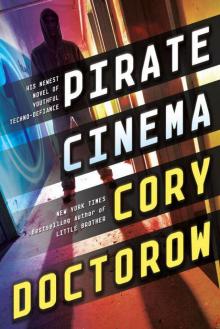 Pirate Cinema
Pirate Cinema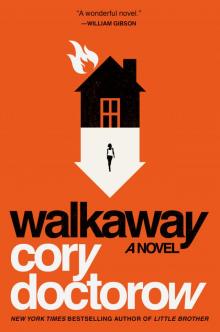 Walkaway
Walkaway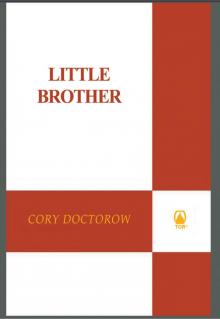 Little Brother
Little Brother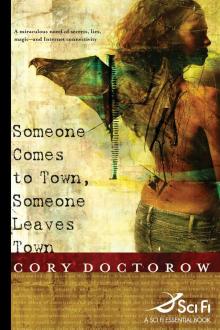 Someone Comes to Town, Someone Leaves Town
Someone Comes to Town, Someone Leaves Town The Great Big Beautiful Tomorrow
The Great Big Beautiful Tomorrow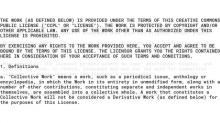 Super Man and the Bug Out
Super Man and the Bug Out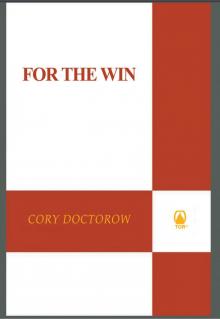 For the Win
For the Win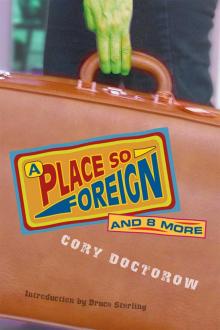 A Place so Foreign
A Place so Foreign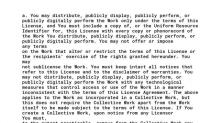 Shadow of the Mothaship
Shadow of the Mothaship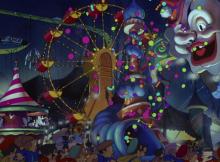 Return to Pleasure Island
Return to Pleasure Island Party Discipline
Party Discipline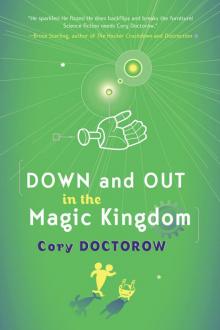 Down and Out in the Magic Kingdom
Down and Out in the Magic Kingdom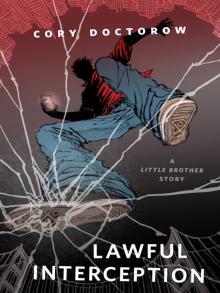 Lawful Interception
Lawful Interception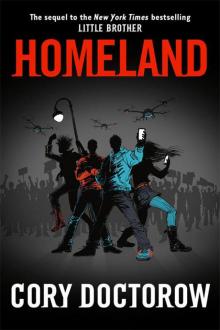 Homeland
Homeland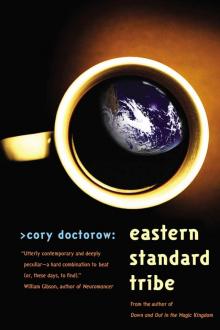 Eastern Standard Tribe
Eastern Standard Tribe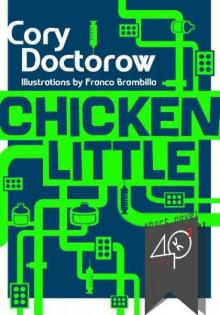 Chicken Little
Chicken Little I, Row-Boat
I, Row-Boat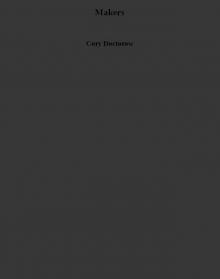 Makers
Makers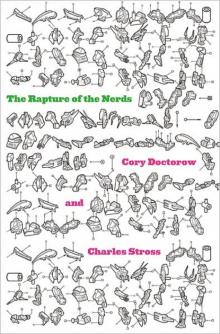 Rapture of the Nerds
Rapture of the Nerds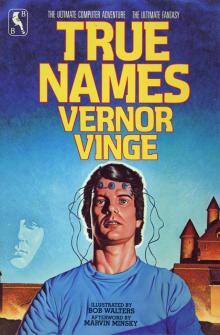 True Names
True Names